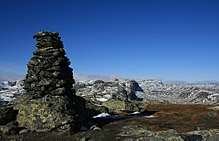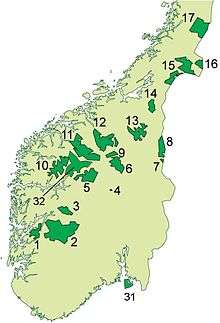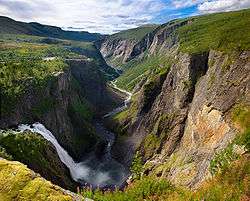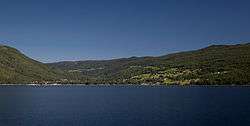Hardangervidda
Hardangervidda is a national park in the counties of Telemark, Buskerud and Hordaland in Norway. It is Norway's biggest national park and contains half of the largest highland plateau in Northern Europe. The park protects Europe's largest wild reindeer herds. Along with for instance Jotunheimen it is one of several mountain areas separating East and West Norway.

Understand


"Vidda" means wide, open plateau in Norwegian. The endless highland plateau of Hardangervidda is about 8500 km², which is 20% the size of the Netherlands 3 times the size of Luxembourg. Hardangervidda national park covers 3,422 km² (1321 square miles). Hardangervidda is famous for the large herds of wild reindeer. An extensive net of hiking paths and thousand lakes and rivers cover the vast highland plateau.
History
People probably came to Hardangervidda at the same time as the reindeer, after the last Ice Age. About 250 Stone Age sites have been found, the oldest dating from 6300 BC. Finds from excavations of Stone Age sites show that the people hunted reindeer and ptarmigan. Moose and trout bones were also found.
Today, the natural resources on Hardangervidda are very valuable for the surrounding villages.
Hardangervidda National Park was established in 1981. It differs from other Norwegian national parks because it has been used a great deal by local people, has many buildings and much privately owned land. Consequently, people use motorized vehicles to harvest resources like fish and game, to upkeep buildings and to run lodges and huts for hikers and skiers. Large flocks of sheep graze Hardangervidda each summer. Locals and tourists come to Hardangervidda to fish and hunt, as a source of food or recreation.
Landscape

Hardangervidda is a barren, treeless mountain plateau at 1100-1200 metres (3600-3900 feet) elevation, with lakes, moors, rivers and streams. This kind of open, relatively even landscape is known as vidde in Norwegian. There are significant differences between the west side, which is dominated by rocky terrain and expanses of bare rock, and the east side, which is much flatter and more heavily vegetated. The prominent peak of Hårteigen 1,690 m (5,545 ft) is visible across much of the plateau.
About 550 million years ago, the plateau was submerged. Gradually a sheet of rock drifted over the seabed, was compressed, folded and rose from the sea. What is now Western Norway rose the most, and greater erosion created deeper valleys, fjords and steeper mountains than in the east. Glaciers and melting ice at the end of the last ice age chiselled out the landscape we see today.
Flora and fauna

The whole of the Hardangervidda is above the tree line. Its alpine climate enables the presence of many species of arctic animals and plants further south than anywhere else in Europe.
Norway is, to all extents and purposes, the only country in Europe with remaining vestigial populations of the original wild mountain reindeer. Wild reindeer need Hardangervidda. The 9000 wild reindeer (2009) here make up more than a quarter of all the wild reindeer in Norway. The large, continuous unspoiled area makes Hardangervidda particularly attractive to wild reindeer. Because the herds migrate between seasonal pastures and calving areas over the course of the year, they need a wide area. Wild reindeer are at their most vulnerable on the winter pasture and in the calving season in May. You might think it is easy to spot one of Hardangerviddas 9000 wild reindeer, but that is not the case. They are shy. If you see a herd, consider yourself very lucky. Don’t try to follow them, but stand quietly and enjoy this rare sight. It is particularly important not to disturb wild reindeer during calving season.
The flat landscape with its numerous lakes and wetlands distinguishes Hardangervidda from other mountainous areas in southern Norway. Trout is the most common fish. A permit is needed to fish in rivers and lakes.
The largest populations of many kinds of ducks and other wetland species in southern Norway, live here. The breeding populations of black-throated divers, scaups, velvet scoters, common scoters, dotterels, Temminck’s stints, great snipes and shore larks are particularly valuable.
Climate
.jpg)
The climate is considerably wetter on the west side than on the east. At any time of year, be prepared for sudden changes. The weather in Hardangervidda National Park can change very rapidly from sunny and warm to cold and rainy or even snowy, so it's important to bring along extra layers of clothing, like wool underwear and wind- and waterproof outerwear. For most people, late spring, summer and fall are the best times of year to visit Hardangervidda. Easter skiing across Hardangervidda is also popular, but is recommended for experienced skiers only. The winter storms can be challenging even for polar explorers like Amundsen. Many of the villages and cities surrounding Hardangervidda are popular all year round destinations.
- Summer: June to August. Daytime temperatures range from 10 to 20°C and occasionally over 20°C in lower elevations. Nights are usually cool (between 10 and 0°C), but temperatures rarely drop below freezing at higher elevations. In general, there is no snow on Hardangervidda in summertime. In June though, there might be some areas still left snow covered.
- Spring and Fall: May and September. Daytime temperatures range from 0 to 15°C with 0 to -10°C in the night. A lot of the plateau remains snow covered in May, and early June there will still be some left at higher elevations.
- Winter: October to April. Temperatures often range from 5 to - 15°C throughout the day, but temperatures as low as -30 °C can occur. In the nighttime, temperatures are usually below zero. Snowfall is highly variable. Sometimes, the ground is snow-covered from October to May, other years the snow might not cover most of Hardangervidda before December.
Get in

There are a several gateways to Hardangervidda national park. Gateway cities and villages are Odda and Eidfjord in the Hardanger region and the mountain destinations Geilo, Uvdal, Rjukan, Rauland, Haukeli, Haukelifjell and Røldal.
By air
Hardangervidda is a 2-3 hours drive from the major airports. The closest major airports are Bergen Airport (2½ hours drive to Eidfjord), Oslo Airport Gardermoen (3½ hours drive to Rjukan),Oslo Airport Torp in Sandefjord (3 hours drive to Rauland), Kristiansand Airport (3 hours drive to Haukeli) and Haugesund Airport (2 hours drive to Odda).
By car
![]()
From Oslo to Hardangervidda by car 1) E 18 from Oslo to Drammen. From Drammen, follow E134 to Notodden. From here you can follow rv. 361 and rv. 37 to Rjukan, or continue on E134 to Åmot in Telemark and then take rv. 37 to Rauland. 2) E18 from Oslo to Sandvika. From Sandvika you take E16 to Hønefoss and from Hønefoss you follow rv. 7 to Geilo.
From Bergen to Hardangervidda by car E16 to Voss and then rv. 13 to Granvin. You then continue on rv. 7 to Eidfjord and then drive to Geilo. You can also start exploring Hardangervidda from Ulvik and Kinsarvik/Ullensvang.
You can drive to the gateways and see the mountain plateau from your car, but there are no public roads for driving inside the national park border.
By train

From Oslo to Hardangervidda by train You can take the train from Oslo to Bø in Telemark. From there you can catch "Haukeliekspressen" to Rauland. You can also take the Bergen Railway from Oslo to a number of places that are great starting points for exploring the northern Hardangervidda – Myrdal, Hallingskeid, Finse, Haugastøl, Ustaoset and Geilo.
From Bergen to Hardangervidda by train The Bergen Railway stops at number of places that are great starting points for exploring Hardangervidda – Myrdal, Hallingskeid, Finse, Haugastøl, Ustaoset and Geilo. You can also take the train to Voss and a bus from Voss to Eidfjord.
By bus
From Oslo to Hardangervidda by bus Take "Haukeliekspressen" to Haukeli or take the bus to Geilo or Rjukan – both good starting points for exploring Hardangervidda.
From Bergen to Hardangervidda by bus Take the bus from Bergen to Voss. From Voss catch a bus to Eidfjord.
Fees and permits
There are no public roads for driving inside the national park border, and no entrance fees to get in to the national park.
You need to buy permits to go fishing or hunting on Hardangervidda. Children under 16 years fish for free. Because more than half of Hardangervidda is owned by private land owners, there is no common fishing permit for all the lakes on Hardangervidda. But there are some common fishing permits for larger areas, like the Hardangervidda west, the Hardangervidda east, Vinjes part of Hardangervidda, Ullensvang, and Møsvatn permits. A 24-hour fishing permit ranges from 50 to 70kr, and a week permit from 100 to 300kr (2010). You can buy the permits at the tourist information offices, cabins, hotels and lodges in the area close to your favourite lake, or go to (this site is in Norwegian).
Get around

By car
Driving Hardangervidda National Park Route is a great way to experience the scenery around Hardangervidda. Drive further, from fjell to fjord on E 134 over Haukelifjell and continue on rv 13 to Hardanger with Odda, Eidfjord and further on rv 7 over Hardangervidda to Geilo, along the national tourist route. This must be the ultimate Hardangervidda driving experience with fjords, Vøringfossen and mountains in 2-3 days.
You can drive to the gateways and see the mountain plateau from your car, but there are no public roads for driving inside the national park border. This is where you can get close to the national park by car:
- Route 7 across Hardangervidda; several convenient stops and branch roads to the national park.
- Route 40 from Nore and Uvdal to Geilo, several stopping places and branch roads to the national park.
- Route 364 to Tinn Austbygd, branch off to Breisetdalen and park at Stegaros or Synken; boat across Mårvatnet from Synken to Mårbu.
- Route 37 to Skinnarbu by Møsvatn and continue on the boat Fjellvåken to the lodge at Mogen.
- E 134 from Haukeli to Jøsendal, several stops and branch roads to the national park.
- The route from Jøsendal to Brimnes, several stops and branch roads to the national park.
On foot
Once you get out of your car and set your feet on the great mountain plains, the best way of getting around is hiking, skiing, cycling and horseback riding. You have to hike some hours to get into the national park, depending on which gateway you choose. Try the extensive network of hiking trails and cabins offered by The Norwgian Trekking Association . Cycling is only allowed on a few tractor roads inside the national park, but you can still experience Hardangervidda on bicycle. Try the famous Rallarvegen , or cycling from Rjukan to Kalhovd
See
- 🌍 Hardangervidda National Park Centre, Møsvatn, Rjukan, ☎ +47 97074300, e-mail: stale@hardangervidda.com. June, July, August: every day 10:00-16:00. An award winning permanent, interactive exhibition about the nature at Hardannervidda. It also includes the Wild Reindeer Exhibition, a cinema and the Café Panorama.
East: Geilo and Uvdal
South: Rjukan, Rauland, Haukelifjell and Røldal

Austbygde (38 km northeast of Rjukan). Austbygde is a small, charming village with a beautiful rural landscape and great views of lake Tinnsjøen.
Rjukan (175 km northwest of Oslo). In the early 20th century, the Norsk Hydro and the industry arrived and changed life in Vestfjorddalen dramatically. Between 1907 and 1920, the farms of Bøen and Saaheim were transformed into the town of Rjukan. The population increased from 369 to over 9,000 in 20 years. Norsk Hydro commissioned Norway’s leading engineers and architects to design the entire town. Rjukan is home to Vemork, where famous saboteurs destroyed 500 kg of heavy water during World War II. Today, about 3300 people live in the small town, which is applying for UNESCO World Heritage status.
Gaustatoppen (15 km from Rjukan). Gaustatoppen is at 1883 m elevation and is one of Norway's most majestic mountains. You can admire it from a distance on your way to Rjukan or one of the villages nearby. You can also climb it, like 25,000 others do each year. It will take you about 5 hours both ways. You will get your reward on the top, where you can see one fifth of Norway on a sunny day.
Krossobanen (2,5 km from Rjukan town centre). In the depths of the valley, Rjukan is overshadowed by Gaustatoppen throughout the winter. Since 1925 the townsfolk have celebrated the sun's return in March with Solfesten, a lively carnival. Why shouldn’t these sun-starved people enjoy easy access to some winter sun? In 1928, Norsk Hydro granted them their wish, opening the Krossobanen, a 5-minute aerial tramway ride into the mountains. Today, you can ride the “sunshine car” up to Hardangervidda daily all year round, and enjoy the magnificent view of the valley and Gaustatoppen.
West: Hardanger with Odda, Ullensvang and Eidfjord
North: rv 7 over Hardangervidda
Do
- High Mountain Cruise by the M/B Fjellvåken
- Hiking, summer and winter
- From one cottage at the mountain plateau to an other
- Cross country skiing and kiting
- Climb mountain peaks
- Bird watching, reindeer observation
- Fishing in small mountain lakes (requires fishing license)
- Picking berries (such as cloudberries) and mushrooms
Buy
Eat
East: Geilo and Uvdal
South: Rjukan, Rauland, Haukelifjell and Røldal
West: Hardanger with Odda, Ullensvang and Eidfjord
North: rv 7 over Hardangervidda
Drink
Sleep


Lodging
East: Geilo and Uvdal
South: Rjukan, Rauland, Haukelifjell and Røldal
West: Hardanger with Odda, Ullensvang and Eidfjord
North: rv 7 over Hardangervidda
🌍 Fagerheim Fjellstugu (in the middle of Hardangervidda, next to road 7). Has road access throughout the year. 1,170 m, you can gaze across a glittering mountain lake and enjoy fantastic views in all directions – not least towards the impressive Hardangerjøkulen glacier. Recently restored mountain lodge with pleasant common rooms, a fireplace and bedrooms with a touch of nostalgia. No en suite rooms, and no whirlpool baths! Separate showers for men and women. 20 rooms/55 beds. You will not have to share with people you do not know. If you have a dog, it is welcome to stay in your room. Weekly rentals of brand new luxury apartments with panoramic views of Hardangerjøkulen. Mountain café during the Easter holidays and over the summer. You will be served decent, hearty, well-made food, with no frills. We made good use of what nature has to offer and our meals include trout from the surrounding waters, as well as game, mushrooms and berries from nature's larder. You may not be able to choose from a ten-course menu, but a good filling meal of traditional food. Fully licensed.
Camping
East: Geilo and Uvdal
South: Rjukan, Rauland, Haukelifjell and Røldal
West: Hardanger with Odda, Ullensvang and Eidfjord
North: Rv 7 over Hardangervidda
Backcountry
Stay safe
Hardangervidda is largely above the treeline and temperatures can drop to zero (0°C) even at mid summer. Drivers should be aware of slippery road in spring and autumn when driving is fine in the lowland. During winter blizzards can make driving challenging and the road is often closed. Hikers must bring map and compass, navigation can be very difficult in fog or stormy weather. Hikers must be prepared for all sorts of weather.
Go next
- Jotunheimen mountains
- Hardanger fjord district
- Flåm, Sognefjord
- Geilo, Hallingdal, Buskerud
| Routes through Hardangervidda |
| Eidfjord ← | W |
→ Geilo |